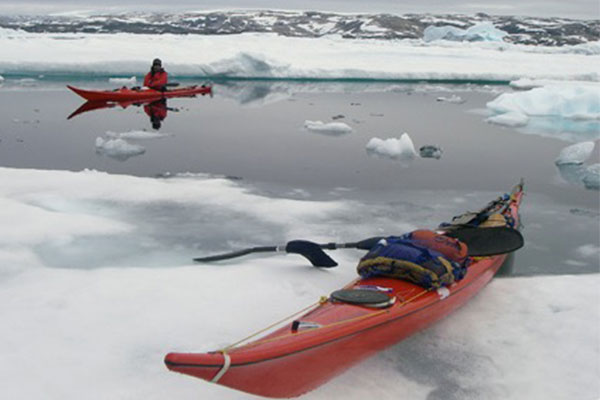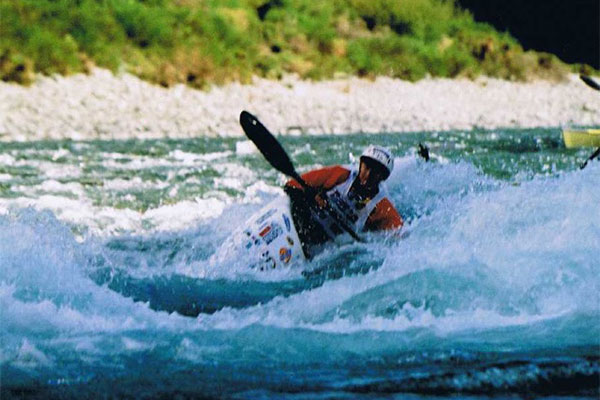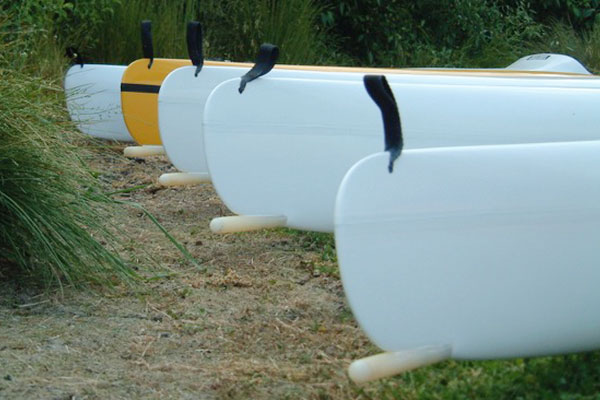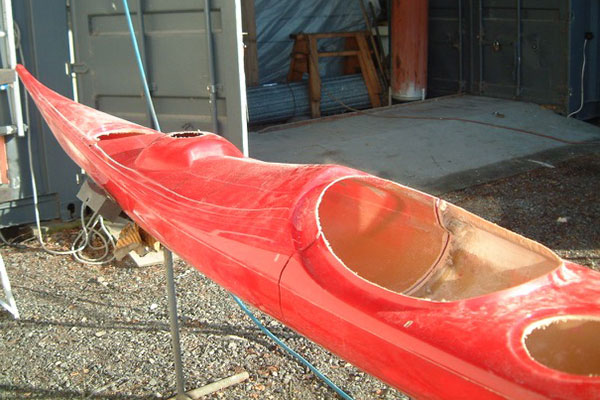There are beginner paddlers. There are intermediate paddlers. There are advanced paddlers. There are failed paddlers also known as swimmers.
Sisson Kayaks recognises the above facts – and even though my first real kayak trip down a river was in 1966 – I still remember how terrifying it can feel to be a beginner on a big river. So the kayak-choice advise we give is based on honest conservative thinking that leads to customer satisfaction on the water.
With this in mind, Sisson Kayaks offers a complete range of kayaks that are designed to optimise the efforts of beginner, intermediate and advanced paddlers.
Our sea kayaks are embraced by some of the world’s greatest expedition paddlers. As I write this in August 2007, Paul Caffyn is paddling his brand new bolt-in-two Nordkapp amongst the ice in Greenland. This is exactly 30 years after he bought his first New Zealand-circumnavigation Nordkapp.
Our Evolutions are used by some of the worlds greatest multisporters. Keith Murray set his Speights Coast to Coast record in 1994. Keith used an Evolution Classic to set his record. His record has yet to be challenged.
Our Eliminator and Esprit beginners kayaks have proven to be high performers in the hands of thousands of realistic paddlers. Some have placed highly in actual race results.
What about our mid-range intermediate kayaks? They sell slowly to realistic paddlers. Our mid-range multisport kayaks are perceived by the market as being too short. Perception only – fuelled too often by kayak store staff desperate to move their own dead-stock multisport barges.
Sadly, we now live in a world dominated by mass marketers who have cultivated the personal use of vanity, ego and image. Few paddlers want to be seen as beginners. And the intermediate paddlers all seem to demand mid-range kayaks that look like the long kayaks used by advanced paddlers. To these paddlers – their kayak must look advanced – especially while on the roof of their car. Bad call!
In order to provide the intermediate stability needed, a mid-range kayak must be wider in the beam. By making this same mid-range kayak 6.1 metres long, the wetted area (hull surface in contact with the water) increases. Sadly, the drag also increases. Such wide and long kayaks are now recognised by many paddlers as “barges”. These barges do not – and can not – ‘run’ between paddle strokes. Surge – slow – surge – slow – surge – slow – it would almost make you sea sick if you stand well back and just focus on the paddlers head. Surge slow surge slow surge slow….. wow – what a way to waste your effort.
We refuse to build such a barge. Our honesty continuously costs us sales. But we retain our conviction that our kayak models must all ‘run’ between paddle strokes.
Sea Kayaks and Multisport Racing kayaks are all pure displacement vessels. They perform best when paddled aerobically. As such, their operating speed is matched to the heart rate that the paddler can sustain over the length of the trip.
The laws of physics dictate that longer, narrower kayaks will move faster with a given power input, than shorter, wider kayaks. Narrow but short kayaks suffer excess draft resulting in higher wetted area and drag. Wide but long kayaks suffer excess buoyancy resulting in shortening of the waterline. Excess wetted area and resultant drag can also be a problem on wide+long designs.
The Curly Question so often asked involves the kayak model Utopian Dream listed in the chart below:-
Q: “I’ve been paddling an Esprit for a while now as my first multisport boat, and have found it great to learn in, but am now looking to move up into something a bit quicker.. Still want to have a boat with a fair bit of primary stability (flattish bottom), but didn’t really think that the Nucleus had this – seems more curved like an Evo, so has put me off it a bit & I am still looking… I know there are a few other boats out there, so it surprised me that this type of boat is something that seems to be missing from your range, and where a lot of paddlers want to be. Why don’t you make a new 5.5m long model by combining the lines of the Esprit and the Evolution?”
A: “I suspect that the boat you need to look at is in fact the (in the middle) Centrix. Nucleus also means in the middle. Including the Defender we already list 5 (honest performing) mid-range designs.
The Utopian Dream mid-range boat you describe can never be honestly marketed – by any manufacturer. Balancing the kayak through the seat (as suggested by asking for a flattish bottom) is not a viable option in any narrow design. That is because as kayaks are made narrower, the paddler needs to re-programme his or her brain to improve balance skills plus (more importantly) support-off-the-paddle-forward-stroke skills.
The weak link in this midrange market is in fact under-developed paddler skill – coupled with just a little vanity.
Other manufacturers have made multisport kayak models that are long (speed implied) and (at the same time) wide (stability implied). Some of these models are in fact just high-drag-barges. These ‘Utopian Dream’ kayaks get blown sideways by the wind because they are also over-buoyant. They end up having too much drag (paddler hits-the-wall after two hours) induced by high-wetted-area. This ‘Utopian Dream’ kayak’s (lack of) performance factor cannot be modified without a complete re-write of the laws of physics. To honestly sell ‘Utopian Dream’ type kayaks the salesman would need to have had training in the marketing of Snake Oil and ‘Wars-On-Terror’.
In the sport of Multisport (and Sea Kayaking), low wetted area designs will always help the energy-deprived (‘hit-the-wall’ – stuffed) paddler make better distance-made-good toward the finish line. Our customers know that – even if they do not always fully understand the reason why.
There is also another poorly understood factor relating to a paddler “falling out” of a ‘fast’ kayak. In fact the paddler may well have been catapulted out! This is because a longer – narrower design usually needs greater draft (depth) to keep the total waterline design in contact with the water. This draft can act as a ‘spring’. If the paddler moves their mass off the centre line of balance – the kayak says “WOW – I am unloaded and heading up”! The unskilled paddler swims. This would definitely be a disguised ‘feature’ of your suggested ‘Utopian Dream’ kayak design.
Oh – how I wish I could be an ‘innocent’ copycat kayak builder. Such total ignorance would surely engender guilt free bliss! But, at Sisson Kayaks we know all of the above mentioned physics factors too well. The reason we do not offer the ‘Utopian Dream’ model in our range is very simple. To do so would be blatantly dishonest!” End of answer.
All Sisson Kayak designs seek to match the length, width, buoyancy and wetted area so that they have the lowest possible drag when paddled aerobically. Proven over many years!
Stability can be expressed in two ways. Primary stability is experienced by the paddler when the kayak is flat and level on smooth water. The water plane stays unchanged. Secondary stability is experienced when the paddler relaxes the hips and allows the kayak to tilt. The water plane widens as the flair on the hull sides is pressed into the water.
See the Kayak Comparison Table below to find out which kayak has the features you require. At the very bottom of the chart is a comparative listing for a typical ICF Olympic K1. Sisson Kayaks do not build ICF Olympic K1’s but we list it here so that overseas readers can gain some base speed / stability comparison information. If you wish to find out more about any particular kayak, click on the name to go directly to it’s specification page.
If you still can’t decide which kayak is for you, or you’re suffering from information overload, call us on 027 2755 499 or email us and we’ll talk you through it!
Centrix = In the middle
Nucleus = In the middle
We chose both of these names because they meant – In the middle (of our range). Neither the Nucleus range nor the Centrix are ‘beginners’ kayaks. They are ‘incremental’ mid-range kayaks for use by competent mid-range paddlers who possess genuine, proven paddle support skills. Such paddlers are relaxed and NEVER resort to support-off-the-bottom (seat-pan) that does not work in any kayak narrower than an Eliminator.
That said, it remains a mystery to us as to why these mid-range paddlers do not all hone their skills that little bit more and use a ‘real’ kayak – an Evolution.



